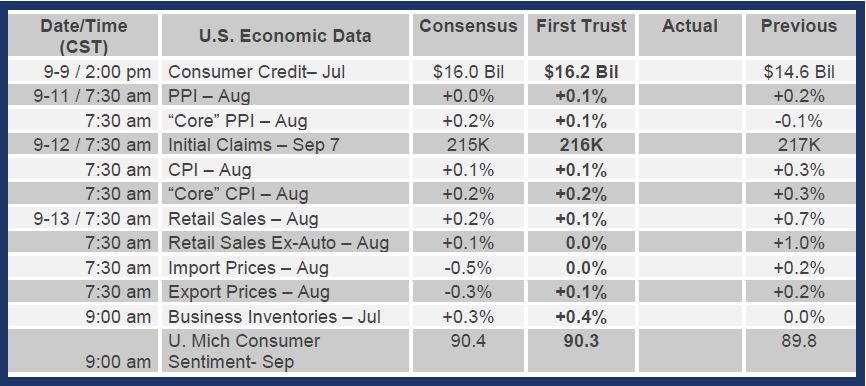Brian Wesbury Weekly Outlook
10.09.2019 17:22 - First Trust Global Portfolios Limited

Rorschach Economics
We’ve all heard of the Rorschach test - you know, the one where you look at an ink blot and say what you see. The theory is that it’s a tunnel into someone’s subconscious thoughts or desires. If you’re obsessed with hockey you might look at an ink splotch and see hockey sticks, or pucks, a Stanley Cup, or even Bobby Orr; if someone is obsessed with outer space, she could look at the same picture and see flying saucers or aliens.
These tests come to mind because lately, three dominant types of economic thought seem to analyze every data point and come to conclusions that always support their particular interpretation of the US economy.
One group is obsessed with President Trump’s tariffs, thinking they are slowing the economy. They even search the internet and earnings calls to find mentions of “trade uncertainty” to prove their point. But uncertainty is one thing, data are quite another. Total US trade in goods and services (exports plus imports, combined) was $4.9 trillion in 2016. In the past twelve months, it’s been $5.7 trillion, an increase of 16.3%. In other words, trade has grown faster than the overall economy.
Yes, we know trade tensions with China are real and important for some companies. And yes, we look forward to the US reaching an agreement with China. But the Middle Kingdom is not the be-all end-all when it comes to world trade. Supply chains are moving - trade is dynamic - which is why the costs to the US economy have been far less than static analysis predicted.
So far this year, US imports from China are down 12.3% from the same period in 2018, but imports from Vietnam are up 33.2%, and they are up 20.2% from Taiwan, 9.8% from South Korea, 9.7% from India, and 6.3% from Mexico. Meanwhile, we’re confident that Congress will pass the new version of NAFTA by early 2020, facilitating stronger trade ties with Canada and Mexico. Trade is moving forward, not dying.
The second major thought group consists of those who oppose the president’s policies in general and are looking for any way they can to discredit the tax cuts and deregulation. They love to focus on supposedly weak business investment, which they say signals the ineffectiveness of the president’s policies.
The problem with this theory is that, since the tax cut was enacted at the end of 2017, “real” (inflation-adjusted) business investment in equipment has grown at a 3.4% annual rate, while real business fixed investment (equipment, structures, and intellectual property) has grown at a 4.5% annual rate. These are respectable numbers. It was inventories that held down GDP growth back in Q2, and this can’t last with a strong consumer.
Moreover, productivity growth (the growth in worker output per hour) has accelerated, growing at a 1.7% annualized rate since the start of 2018 (and up at a faster 2.9% annualized rate so far in 2019), versus a 0.9% annualized rate for the four years ending in 2016.
The last of the three thought groups have been obsessing about the next recession since the moment the last one ended. Any day now they expect the “sugar high” to end.
They celebrated when the ISM Manufacturing index dropped to 49.1 last week, but then the ISM index for the much larger service sector surprised on the high side at 56.4. For every data point that signals a slowdown, there are nine that don’t.
For example, a soft 130,000 gain in headline payroll growth for August dominated headlines, but civilian employment (which includes small business) surged 590,000, wage growth picked up, labor force participation moved higher, initial claims remained low, and auto and truck sales rose. Not exactly negative news.
If someone has an axe to grind about the US economy, we’re sure they’ll see a recession in whatever blot or piece of data they look at. They can always find something to worry about. Nonetheless, we continue to believe that optimism should be the default position for investors when it comes to the US.
Brian S. Wesbury - Chief Economist
Robert Stein, CFA – Deputy Chief Economist
